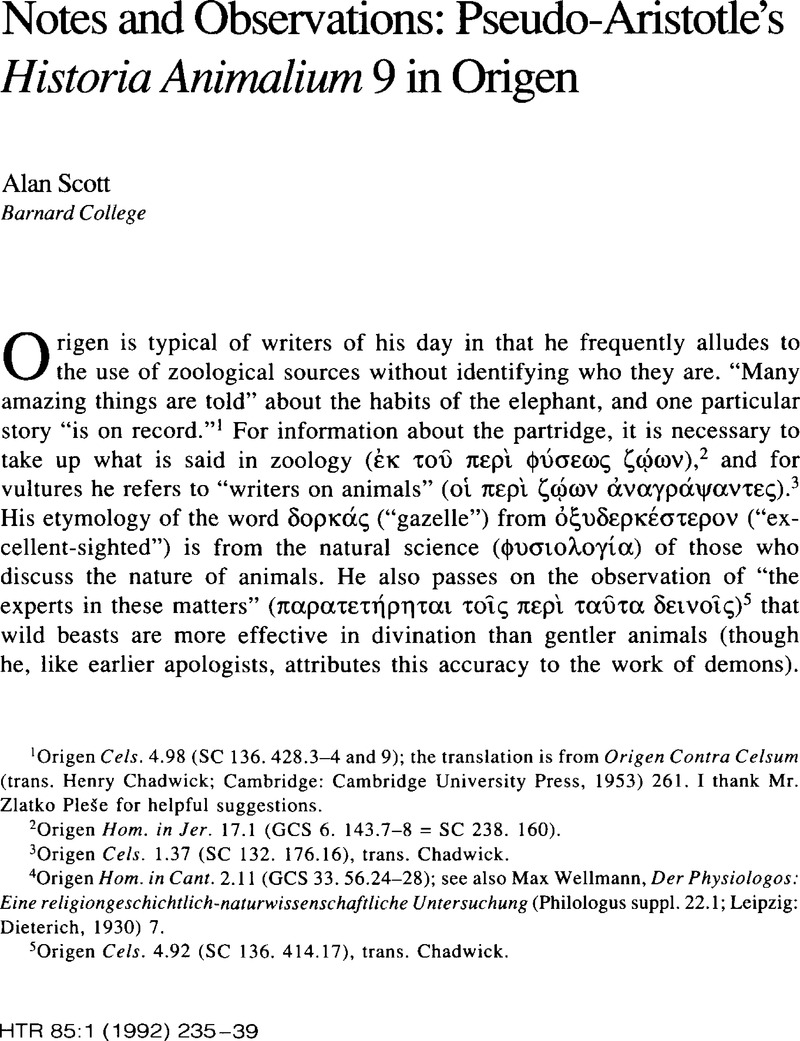No CrossRef data available.
Published online by Cambridge University Press: 10 June 2011

1 Origen Cels. 4.98 (SC 136. 428.3–4 and 9); the translation is from Origen Contra Celsum (trans. Henry Chadwick; Cambridge: Cambridge University Press, 1953) 261. I thank Mr. Zlatko Pleše for helpful suggestions.
2 Origen Horn, in Jer. 17.1 (GCS 6. 143.7–8 = SC 238. 160).
3 Origen Cels. 1.37 (SC 132. 176.16), trans. Chadwick.
4 Origen Horn, in Cant. 2.11 (GCS 33. 56.24–28); see also Wellmann, Max, Der Physiologos: Eine religiongeschichtlich-naturwissenschaftliche Untersuchung (Philologus suppl. 22.1; Leipzig: Dieterich, 1930) 7Google Scholar.
5 Origen Cels. 4.92 (SC 136. 414.17), trans. Chadwick.
6 Compare Origen's citation of unnamed “experts” explaining the causes of thunder(Horn, in Jer. 8.4 [GCS 6. 60.1–8]), his references to mineralogists, τoῖς περὶ λίθων πραγματευσαμένoις (Comm. in Matt. 10.7 [GCS 40. 7.6–7 and 9.13]), to botanists, “hi, quibus intellectus herbarum pigmentorumque peritia”(Horn, in Cant. 1 [GCS 33. 106.8–9], compare Horn, in Cant. 3 [GCS 33. 192.9–16]), and to those, “qui medicinae peritiam gerunt,” (Horn, in Num. 17.1 [GCS 30. 154.25]).
7 In general see Neuschäfer, Bernhard, Origenes ah Philologe (Basel: Reinhardt, 1987)Google Scholar.
8 The ninth book seems to have been derived in large part from Theophrastus's De animalium prudentia et moribus; it was cited as Aristotle's from an early date, see Regenbogen, O., “Theophrastos,” PWSup 7 (1940) 1424Google Scholar; Dieraurer, Urs, Tier und Mensch im Denken der Antike (Amsterdam: Grüner, 1977) 107Google Scholar. For a different opinion see Balme, David M., ed. and trans., Aristotle. History of Animals. Books VII–X (LCL; Cambridge, MA: Harvard University Press, 1991) 10–13Google Scholar.
9 The only earlier interpretation I can find is in Hippolytus(Demonstratio de Christo et antichristo 54) who says it refers to the devil; Origen will have the same interpretation.
10 Origen Horn, in Jer. 17.1 (GCS 6. 143.10–44.6 = SC 238.160).
11 Pseudo-Aristotle Hist. An. 9.8 (613b17–614a3); the translation is from The Works of Aristotle, vol. 4: Historia Animalium (trans. Thompson, D'Arcy Wentworth; Oxford: Clarendon, 1910)Google Scholar.
12 Thompson, D'Arcy Wentworth, A Glossary of Greek Birds (2d ed.; London: Oxford University Press, 1936) 235–36Google Scholar; Terian, Abraham, ed. and trans., Philonis Alexandrini De Animalibus: The Armenian Text (Studies in Hellenistic Judaism 1; Chico, CA: Scholars Press, 1981) 151Google Scholar.
13 The deceit is generally attributed to “partridges” in Philo De animalibus 35; Antigonus Historium mirabilium collectio 39 [45]; Scholia on Aristophanes Aves 768 (see White, John William, ed., The Scholia on the Aves of Aristophanes [1914; reprinted Hildesheim/New York: Olms, 1974] 146)Google Scholar.
14 So in Callimachus frag. 415 (see Pfeiffer, Rudolf, ed., Callimachi Fragmenta nuper reperta [Bonn: Marcus & Weber, 1923]Google Scholar), and the Geoponica 14.20 (see Beckh, Henricus, ed., Geoponica [Leipzig: Teubner, 1895]Google Scholar 424.11–21).
15 Origen Horn, in Cant. 2 (GCS 33. 155.16–20); the translation is from Origen, The Song of Songs: Commentary and Homilies (trans, and ed. Lawson, R. P.; ACW 26; Westminster, MD: Newman, 1957) 146Google Scholar.
16 Pseudo-Aristotle Hist. An. 9.7 (612b32–34 [pigeon]; 613a14–16 [turtle-dove]).
17 So Philo Quis rerum divinarum heres sit 234; Physiologus 28 (see Sbordone, F., ed., Physiologus [Rome: Dante Alighieri-Albrighi, Segati, 1936] 92–93Google Scholar; Offermanns, D., Der Physiologus nach den Handschriften G und M [Meisenheim am Glan: Hain, 1966] 96–97Google Scholar; Kaimakis, D., Der Physiologus nach der ersten Redaktion [Meisenheim am Glan: Hain, 1974] 80–81)Google Scholar; Cyranides 43 (see Kaimakis, D., ed., Die Kyraniden [Meisenheim am Glan: Hain, 1976] 231Google Scholar); Basil Homiliae in Hexaemeron 8.6 (SC 26. 458); also Origen Horn, in Lev. 2.2 (SC 286. 94.9–12).
18 See Heine, Ronald E., “Can the Catena Fragments of Origen's Commentary on John be Trusted?” VC 40 (1986) 118–34Google Scholar, esp. 131.
19 2 Kgs 25:7.
20 2 Kgs 25:8–9.
21 Origen frag. 3 In Jer. (GCS 6. 199–200); for Pierre Nautin's strong reservations about authenticity see SC 232. 29–30. Erich Klostermann cites parallels to this passage in Pseudo-Eustathius, but the latter apparently has used Origen as a source: see Zoepfl, Friedrich, Der Kommentar des Pseudo-Eustathios zum Hexaëmeron (Münster: Aschendorff, 1927) 23Google Scholar.
22 Pseudo-Aristotle Hist. An. 9.44 (629b27–29).
23 So Polybius Historiae 34.16.2 = Pliny Hist. Nat. 8.18.47. Polybius assures us that some of these lions were crucified as an example to the others.
24 Aristotle Hist. An. 3.7 (516b10–12); idem Part. An. 2.9 (655a14–16); later writers include Aelian Nat. An. 4.34.
25 Supplementum Aristotelium, vol. 1, part 1: Excerptorum Constantini De Natura Animalium Libri Duo. Aristophanes Historia Animalium Epitome (ed. Lambros, S. P.; Commentaria in Aristotelem Graeca; Berlin: Reimer, 1885) 93Google Scholar. 10–13; see also Wellmann, Physiologos, 9, who collects parallels between Origen and Timotheus. For earlier writers see Wellmann, Max, “Timotheos von Gaza,” Hermes 62 (1927) 179–204Google Scholar.
26 It was systematically mined by Antigonus in Historiarum mirabilium collectio 27–60 (32–66) (see Regenbogen, “Theophrastos,” 1407), and is also frequently cited in PseudoAristotle Mirabilium auscultationes (see Fraser, P. M., Ptolemaic Alexandria [3 vols.; Oxford: Clarendon, 1972] 2Google Scholar. 1077 n. 378).
27 See Origen Cels. 5.57 (SC 147. 156.5–9); 6.8 (SC 196. 10); Origen frag. In Ps. 118 (ed. Cadiou, Rene in “L'ile Topaze, fragment de Xénocrate d'Éphèse,” Mélanges offerts à A. M. Desrousseaux par ses amis et ses élèves [Paris: Hachette, 1937] 27–33Google Scholar).